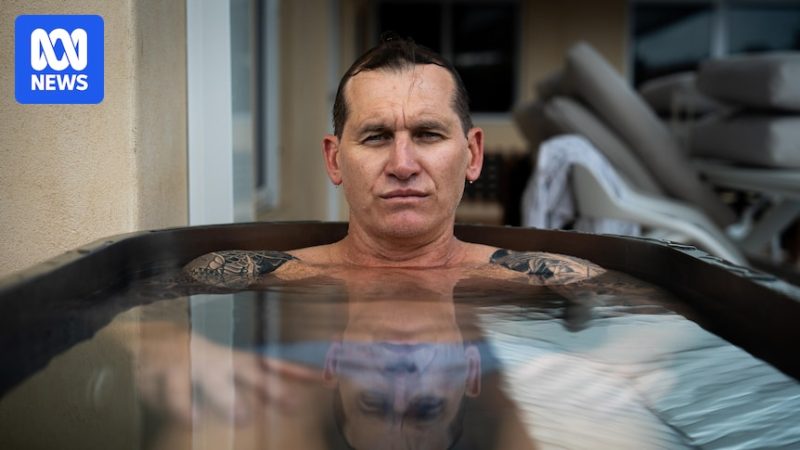Former navy clearance divers suffering mysterious brain injuries years after service

Warning: This article contains references to mental health, suicide and family violence.
A decade after Micheal Barnes returned from a tour of Afghanistan, he woke up one morning and threatened to assault a motorist on his way to work.
“I’ve come very close to pulling someone out the window of their car … driving to work one day,” the former navy clearance diver said.
The 47-year-old said the rage boiled up out of nowhere and was “very irrational”, but at the time, he couldn’t stop it.
Micheal Barnes has always had a great love for the water. (ABC News: Cason Ho)
“To walk down to someone’s car because they’re driving too close to you and threaten to hurt them … like when you think about it, who does that?” he said.
Mr Barnes’s mum, Sue Barnes, said she noticed her kind and caring son started to get uncharacteristically angry “over the littlest things.”
“He’d get angry because you didn’t wipe the dishes with a tea towel. It’s hard to explain, but it’s just these constant little things, and they progressively got worse.”
Mr Barnes also remembers yelling at his young daughters for minor indiscretions and losing his temper at his wife – but the road-rage incident was the tipping point for the former warrant officer of the clearance diving team.
“I went to work, and I raised the flag that, you know, there might be something going on here,” he said.
“About three days later, I’d seen a psychiatrist.”
A decade earlier he was deployed to the Middle East as an explosives ordinance disposal expert, and required to detonate hundreds of explosive devices in less than a year.
“I was extremely close to a lot of the detonations that I did by virtue of the fact there were enemies present,” he said.
The shock waves from the blasts were sometimes so strong, he said, at times he felt like he’d been punched in the face.
Sue Barnes is very proud of her son, but says something is now “just not right” with him. (ABC News: Nico White)
Rage was one of a string of recurrent symptoms Mr Barnes had experienced following his deployment, along with chronic headaches, ringing in his ears, dizzy spells and short-term memory loss.
“My long term-memory seems to be okay. But what I did five minutes ago, I couldn’t tell you,” he said.
During a recent visit with her son, his mother noticed he had absolutely no recollection of conversations they’d had just a few weeks earlier.
“He just looked at me and said ‘I don’t know what you’re talking about’,” Sue said.
Put simply, she said, after nearly three decades of service, her son’s once-brilliant brain was “just not right”.
‘Stuff doesn’t add up’
The Royal Australian Navy’s clearance divers are no strangers to risk. The unit was founded in the 1950s to help clear unexploded bombs after World War II.
Now the role is more diverse and includes maritime tactical operations and underwater mine disposal.
Some clearance divers are also attached to the special forces Tactical Assault Group, where they train with heavy weapons and explosives.
Clearance divers like Mr Barnes willingly signed up despite the risk to their lives, but they couldn’t anticipate the prospect that years later, their service could lead to a subtle and pervasive form of brain injury.
Micheal Barnes’s highly decorated navy career spanned three decades. (ABC News: Cason Ho)
Blast over-pressure occurs when a weapon is fired, and the explosion creates an invisible high pressure shock wave which travels through the body — including the brain.
That can deform the delicate jelly-like material and stiff structures within the brain, said neurologist David Rosen.
“The brain is momentarily deformed, compressed, expanded. That deformation has a physical effect on the structures within the jelly.”
That damage often can’t be seen on standard scans, Dr Rosen added. It’s only after death when the brain is dissected that damage and scarring can be seen under the microscope.
The symptoms can take years to manifest and be subtle and hard to pinpoint, but include headaches, short term memory loss, and personality changes like uncharacteristic impulsivity and rage.
Loading…
“I have no doubt that repetitive blast over-pressure does lead to functional abnormalities within the brain,” said Dr Ben Dunkley, a cognitive neuroscientist who has been working with the Department of National Defense in Canada for more than a decade.
Dr Dunkley has been using new kinds of brain imaging known as magneto encephalography (MEG) to compare the brains of living Canadian service personnel exposed to different levels of blast.
“I don’t think at this stage we can categorically say that it’s causal,” he said.
“But we can certainly say that, in those that have more blast, they show greater brain functional abnormalities and a more severe set of symptoms.”
The ABC has spoken to more than 60 current and former ADF personnel who described symptoms of mild traumatic brain injury (mTBI) in themselves or their colleagues that they attributed to blast exposure.
Among them were more than 20 former navy clearance divers who worked with explosives and heavy weapons.
They described a consistent pattern of chronic headaches, memory loss, tinnitus and sudden uncharacteristic outbursts of rage amongst themselves and their colleagues.
Many questioned whether effects of explosions combined with the physiological stress of deep sea diving could increase the impacts on the brain.
“We call it blast brain and bubble brain,” one said. “I’m no scientist, but it can’t be good for you.”
Four different former clearance divers in their 30s or 40s said their memory was now so bad they had to keep a daily diary noting what they’d done because they had no recollection without it.
Several former clearance divers told the ABC they had been hospitalised in mental health facilities and had attempted suicide multiple times.
“There’s something not right … that’s not normal,” one said of the number of colleagues he had known who had either died or attempted suicide.
Data from the United States Department of Defense shows ordinance disposal and diving personnel have the highest rates of suicide of all Defense occupations.
The Australian Royal Commission into Defence and Veteran Suicide, which delivered its final report this week, heard the rate of suicide amongst clearance divers could be up to twice that of the general population.
Almost all the clearance divers who spoke to the ABC had been diagnosed with post-traumatic stress disorder (PTSD), even though some had never been deployed or seen active combat.
“Stuff doesn’t add up,” said Denise Goldsworthy, chair of the Navy Clearance Divers Trust, a trust fund dedicated to providing relief to current and former members.
Micheal Barnes experienced a range of troubling symptoms after leaving the navy. (ABC News: Cason Ho)
She said while some clearance divers clearly did have PTSD from service, many others she spoke to had symptoms that didn’t make sense.
Ms Goldsworthy said in a six-week period earlier this year the trust was aware of 10 clearance divers being hospitalised, seven for mental health issues, including four who had attempted suicide.
“All you can wonder is if there is a high probability that some of these individuals have got physical brain injuries and [if] the PTSD treatments are not working for them.” she said.
Like many who spoke to the ABC, when Mr Barnes sought help for his symptoms, he was quickly diagnosed with PTSD.
“Every single person that goes to a clinic and says, ‘I’m a veteran and I feel a bit depressed’. ‘Oh, bang, you must have PTSD’,” he said.
“It didn’t tie in with what was happening with me … with my memory or my headaches,” he said.
“I just felt like there was more to the situation.”
‘What the hell was wrong with me?’
Adam Baker was drinking too much and in between jobs when he reached breaking point several years ago.
Like many of his former clearance diver colleagues, he had been struggling with short-term memory loss, tinnitus and anger since he left the ADF after 11 years of service.
“I’d had an emotional outburst, aggressive outbursts. In one particular instance, I lost a job because of an aggressive outburst,” the 38-year-old said.
“It was pretty dire at one stage, where suicide was an option.”
Mr Baker moved to the Special Forces Tactical Assault Group training unit at Holsworthy barracks in the early 2000s, where he was exposed to blasts as a method of entry expert, putting explosives on walls and doors.
“The best way I can describe it is like getting kicked in the face,” he said.
Adam Baker joined the navy as a teenager and was a method of entry specialist. (ABC News: Chris GIllette)
After less than a year in the Special Forces he was dismissed following a change in behaviour.
“I think they directed me towards medical and a counselling service or military psychologist to talk about whatever the issue may be,” he said.
“Within an hour … I was out of there, unknown as to what was wrong with me.”
He left the navy altogether not long after.
In the years that followed, his wife, Jo Baker, noticed his symptoms got worse, especially after the birth of their first child.
“Those aggressive outbursts [were something] I’d never really seen before with Adam,” she said.
“I didn’t understand why it was happening. He didn’t understand why it was happening. So it was really, really difficult. she said.
Adam said he would also burst into tears for no reason with no idea “what the hell was wrong with me?”
In 2020, Adam underwent a battery of brain scans and neurological testing, which showed his functioning was impaired. He was diagnosed with a mild Traumatic Brain Injury (mTBI) due to repeated blast exposure.
Adam Baker read books about blast exposure and was shocked to recognise the symptoms others described. (ABC News: Chris Gillette)
His neurologist, David Rosen, wrote in his report that the nature of Adam’s work involving repeated exposure to blasts and an absence of any other explanation left him with “no doubt about the nature of [Adam’s] condition”.
Dr Rosen said he had seen multiple former navy clearance divers with “remarkably similar” presentations with no history of psychiatric illness, mental illness, childhood trauma or anything else that could explain their symptoms.
“That clean slate with only really one factor makes it very likely that [blast exposure] was a major — if not the major — contributory factor,” he said.
The Department of Veterans Affairs accepted Adam’s diagnosis of mTBI in 2021, noting the cause of his condition was likely due to “recurrent concussive head injury due to the effects of recurrent blast injury”.
“The fact that they accepted my claim basically says that they’re aware of it,” Adam said.
“It’s one thing to go and do a job at that level and accept the risk knowing full well what the risks are, but it’s another thing to do the job at a high level without knowing and being told.”
Royal commission recommendations
This week, the Royal Commission into Defence and Veteran Suicide’s final report found traumatic brain injury from blast exposure was “common” in active duty military personnel.
It noted traumatic brain injury was associated with a heightened risk of death by suicide and recommended that a brain injury program be established to understand and mitigate the impact of repetitive low-level blast exposure on the brain.
The report also noted clearance divers faced “unique physiological and psychological stressors on the body” from diving including “the effects of pressure and blast exposure”, but that little research had been done.
In a statement, the ADF said the royal commission has provided an opportunity for Defence to reflect on policies and practices.
“The wellbeing, support, and care of our people remains Defence’s priority” a spokesperson said.
Sue Barnes agrees people like Micheal and his former colleagues need more support. (ABC News: Nico White)
Last month, the US Deputy Defense Secretary ordered immediate action to protect troops in training after finding personnel were experiencing “possible adverse effects on brain health and cognitive performance” from blast over-pressure.
The federal government here is yet to respond to the royal commission’s final report or commit to implementing its recommendations.
The veterans who spoke to the ABC said they were realistic about the ways blast exposure risk could be reduced, especially on deployment.
Many felt more could be done to protect soldiers, especially during special forces training — yet most didn’t want to be seen as weak or “whingers” not prepared to put their bodies on the line.
Micheal Barnes is focusing on his health by cutting back on drinking and using an ice bath and sauna. He’s also spending more time with his family, who have been through so much with him.
He’s hoping to help the many colleagues he’s seen suffer similar symptoms know they aren’t alone.
“It’s not just clearance divers, but it’s, you know, those artillery guys, those infantry guys, it’s a whole raft of ADF people.”
He also wants more veterans to consider donating their brains to the Australian Veterans Brain Bank to help study the impacts of blast.
“If I can create some sort of awareness that helps put some provisions in place to keep them safe, then I feel that putting my head on the chopping block is worthwhile,” he said.
“The wrong people are dealing with the aftermath, and that’s my family – and that’s the bit I have the most trouble with,” he said.
Loading…







